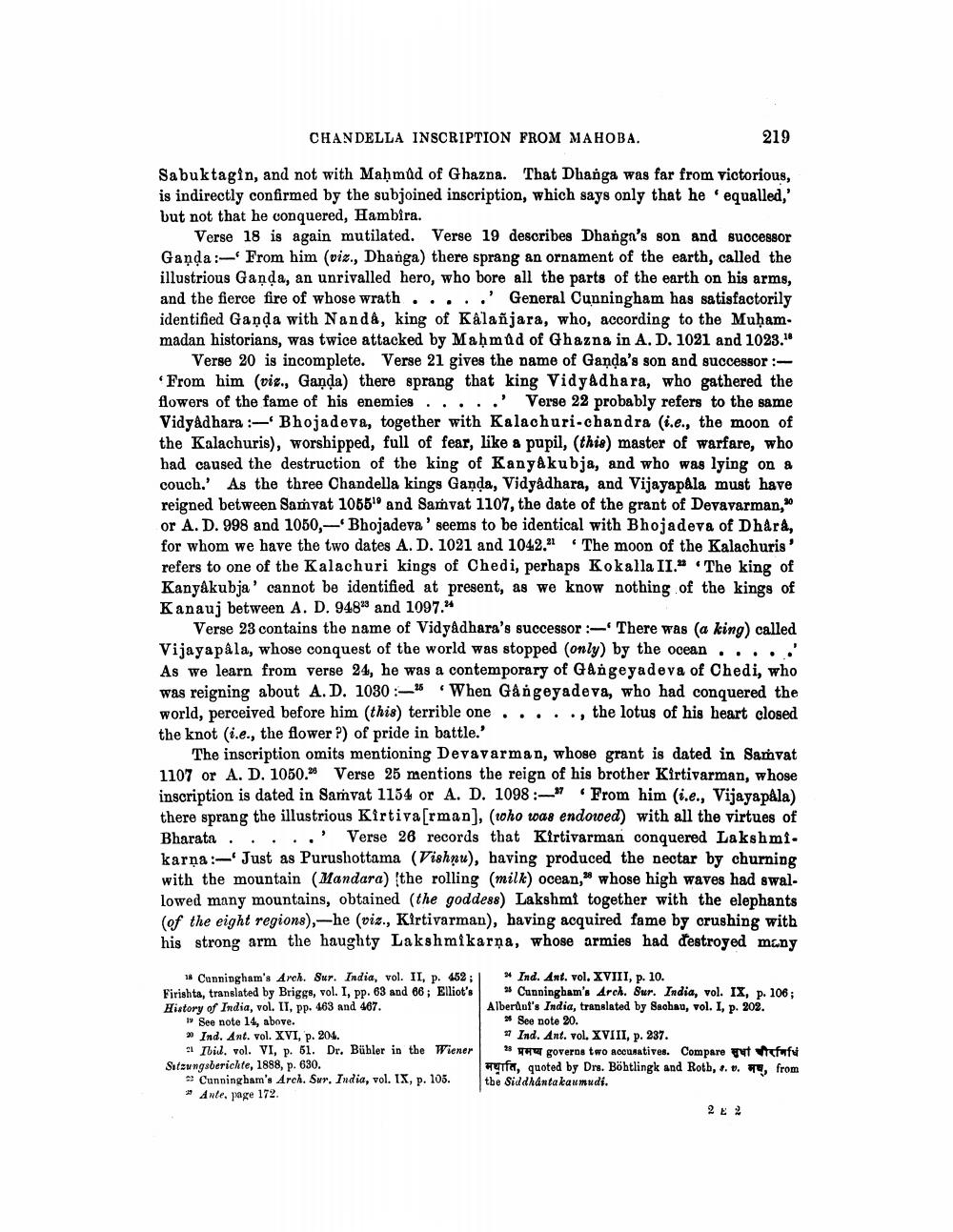________________
CHANDELLA INSCRIPTION FROM MAHOBA.
219
Sabuktagin, and not with Mahmud of Ghazna. That Dhanga was far from victorious, is indirectly confirmed by the subjoined inscription, which says only that he equalled,' but not that he conquered, Hambira.
Verse 18 is again mutilated. Verse 19 describes Dhangn's son and successor Ganda: From him (viz., Dhanga) there sprang an ornament of the earth, called the illustrious Ganda, an unrivalled hero, who bore all the parts of the earth on his arms, and the fierce fire of whose wrath..... General Cunningham has satisfactorily identified Ganda with Nanda, king of Kalañjara, who, according to the Muhammadan historians, was twice attacked by Mahmud of Ghazna in A. D. 1021 and 1023.*
Verse 20 is incomplete. Verse 21 gives the name of Ganda's son and successor :From him (vie., Ganda) there sprang that king Vidyadhara, who gathered the flowers of the fame of his enemies.....' Verse 22 probably refers to the same Vidyadhara :- Bhojadeva, together with Kalachuri.chandra (i.e., the moon of the Kalachuris), worshipped, full of fear, like a pupil, (this) master of warfare, who had caused the destruction of the king of Kanyakubja, and who was lying on a couch. As the three Chandella kings Ganda, Vidyadhara, and Vijayapala must have reigned between Samvat 10551 and Samvat 1107, the date of the grant of Devavarman, 20 or A. D. 998 and 1050,- Bhojadeva' seems to be identical with Bhojadeva of Dhara, for whom we have the two dates A.D. 1021 and 1042. The moon of the Kalachuris' refers to one of the Kalachuri kings of Chedi, perhaps Kokalla II. The king of Kanyakubja' cannot be identified at present, as we know nothing of the kings of Kanauj between A. D. 948% and 1097.4
Verse 23 contains the name of Vidyadhara's successor :- There was (a king) called Vijayapala, whose conquest of the world was stopped (only) by the ocean..... As we learn from verse 24, he was a contemporary of Gangeyadeva of Chedi, who was reigning about A.D. 1030 6 When Gångeyadeva, who had conquered the world, perceived before him (this) terrible one....., the lotus of his heart closed the knot (i.e., the flower ?) of pride in battle.
The inscription omits mentioning Devavarman, whose grant is dated in Samvat 1107 or A. D. 1050. Verse 25 mentions the reign of his brother Kirtivarman, whose inscription is dated in Samvat 1154 or A. D. 1098 :-* From him i.e., Vijayapala) there sprang the illustrious Kirtiva[rman], (toho was endowed) with all the virtues of Bharata.... Verse 26 records that Kirtivarman conquered Lakshmi. karna :- Just as Purushottama (Vishnu), having produced the nectar by churning with the mountain (Mandara) (the rolling (milk) ocean, whose high waves had swallowed many mountains, obtained (the goddess) Lakshmi together with the elephants (of the eight regions),-he (viz., Kirtivarman), having acquired fame by crushing with his strong arm the haughty Lakshmikarņa, whose armies had destroyed many
1 Cunningham's Arch. Sur. India, vol. II, p. 452 : 1 W Ind. Ant. vol. XVIII, p. 10. Firishta, translated by Briggs, vol. I, pp. 63 and 66; Elliot's * Cunningham's Arch. Sur. India, vol. IX, p. 106; History of India, vol. II, pp. 463 and 467.
Alberdui's India, translated by Sachau, vol. I, p. 202. See note 14, above.
* See note 20. » Ind. Ant. vol. XVI, p. 204.
27 Ind. Ant. vol. XVIII, p. 237. - Tbil, vol. VI, p. 51. Dr. Bühler in the Wiener " प्रमण governs two accusatives. Compare सा चौरनिधि Sitzungsberichte, 1888, p. 630.
Fyrfa, quoted by Drs. Böhtlingk and Roth, ... , from Cunningham's Arch. Sur, India, vol. IX, p. 105. the Siddhantakaumudi. *Ante, page 172
2 E




